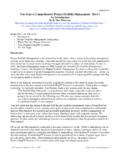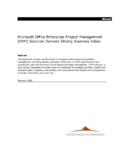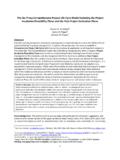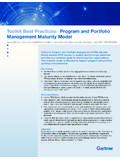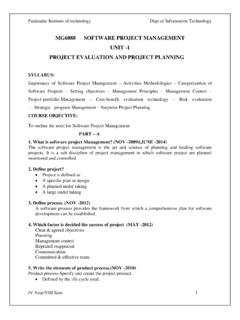Transcription of Combining decision analysis and portfolio …
1 Journal of Petroleum Science and Engineering 44 (2004) 55 65. Combining decision analysis and portfolio management to improve project selection in the exploration and production firm Michael R. Walls Colorado School of Mines, 1500 Illinois Street, Golden, CO 80401-1887, USA. Abstract Recent advances in modern finance theory and decision science are being utilized in a more systematic fashion by the upstream petroleum industry. Corporate planning groups as well as business units in oil companies are increasingly applying techniques such as decision analysis , simulation, portfolio management , and real options analysis to improve the overall decision making and capital allocation process.
2 An important element of improving the practice of risk management in the E&P setting is to ensure the proper integration of these analytical techniques in order to leverage their overall capabilities. The Markowitz optimization approach to portfolio analysis , for example, provides the E&P decision maker an efficient set of portfolios, based on minimizing risk subject to a particular return. However, without some guidance as to what level of risk-taking is appropriate for the E&P firm, the portfolio analysis alone does not provide managerial guidance about which of these efficient portfolios is best for the firm. There are, however, important attributes of the decision analysis paradigm that link directly to choices made by the firm regarding modern portfolio analysis .
3 Preference analysis , an important element of a comprehensive decision analysis , provides us a mechanism for measuring and applying a corporate risk-taking policy. Knowing the firm's attitude about taking financial risk is important in terms of selecting the appropriate portfolio of activities. These linkages between decision analysis and portfolio management can improve the overall decision process, and ultimately, firm performance. D 2004 Elsevier All rights reserved. Keywords: Petroleum risk; portfolio management ; decision analysis ; Preference theory 1. Introduction product price setting, increased pressure to minimize cost structures, diminishing investment opportu- The capital allocation process, and the quality of its nities, a shrinking experienced workforce, and a associated decisions, remains a critical factor influ- cautious capital market.
4 The combination of these encing overall firm performance. This is particularly characteristics provides a compelling motivation for true for petroleum companies where characteristics of managers to implement the most effective technolo- risk and uncertainty are pervasive in this capital gies for allocating capital and improving the overall investment setting. Today's exploration and produc- quality of E&P investment decisions. tion industry is characterized by a highly volatile Relatively recent advances in modern finance the- ory and decision science are being utilized in a more systematic fashion by the upstream petroleum indus- E-mail address: ( Walls).
5 Try. Corporate planning groups as well as business 0920-4105/$ - see front matter D 2004 Elsevier All rights reserved. 56 Walls / Journal of Petroleum Science and Engineering 44 (2004) 55 65. units in oil companies are increasingly applying 2. Modern portfolio management techniques such as decision analysis , simulation, port- folio management , and real options analysis to im- Much of modern portfolio management has been prove the overall decision making and capital motivated by the seminal work of Harry Markowitz allocation process. (Markowitz, 1952) and his well known Markowitz An important element of improving the practice optimization approach.
6 Markowitz demonstrated how of risk management and decision making in the stock investors could select an efficient set of portfo- E&P firm is to ensure the proper integration of lios that would minimize the standard deviation (risk), these analytical techniques in order to leverage their subject to a particular portfolio return (expected overall capabilities. The Markowitz optimization return). Markowitz (1956) showed through a classic approach to portfolio analysis , for example, provides quadratic optimization technique that investors could the E&P decision maker a set of efficient portfolios, virtually eliminate their exposure to the unique or based on minimizing risk subject to a particular unsystematic risk associated with individual securi- return.
7 Without some guidance as to what level of ties. This optimization approach is applied in the risk-taking is appropriate for the E&P firm, the context of a fixed investment amount for the portfolio . portfolio analysis alone does not provide managerial The unsystematic risks are those risks specific to the guidance about which of these efficient portfolios is business or industry. This ability to diversify away the best for the firm. There are, however, important unsystematic risk leaves the stock investor with a attributes of the decision analysis paradigm that link portfolio containing only the systematic or market- directly to choices made by the firm regarding specific risks, such as inflation, purchasing power, and modern portfolio analysis .
8 Preference analysis , an other market-wide risks. As shown in Fig. 1, Marko- important element of a comprehensive decision witz demonstrated that with only a limited number of analysis , provides us a mechanism for measuring properly selected stocks, the investor could virtually and applying a corporate risk-taking policy. Know- eliminate all the unsystematic risk associated with ing the firm's attitude about taking financial risk is individual stocks, leaving only the generally undiver- important in terms of selecting the appropriate sifiable systematic or market risk. portfolio of activities. This integration between de- The basic assumption of modern portfolio theory is cision analysis and portfolio management can im- that decisions are made on the basis of a tradeoff prove the overall decision process, and ultimately, between risk and return.
9 Return is measured by the firm performance. expected value or mean (l) of the probability distri- This paper is organized as follows: first, we provide an overview of modern portfolio theory and demonstrate an application of Markowitz opti- mization for a sample of typical E&P projects. We highlight the key insights from the portfolio analysis and how it provides significant guidance to E&P. decision makers. In the next section we provide an overview of preference analysis and how this theory is applied in the E&P setting in order to estimate the firm's financial risk tolerance. In the third section we integrate these two approaches and demonstrate how the firm can select the optimal portfolio among an efficient set of portfolios by utilizing their current level of financial risk tolerance.
10 In the last section we discuss the implications of this approach and the intuitions that managers can gain from applying such an approach as part of the capital allocation process. Fig. 1. Walls / Journal of Petroleum Science and Engineering 44 (2004) 55 65 57. bution of payoffs for the stock or asset being consid- with selecting an appropriate loss point'' for a ered. Risk is measured by the variance or standard distribution of outcomes. Also, in an analysis based deviation (r) associated with that payoff distribution. on standard deviation, only means, variances and In addition, we make the very reasonable assumption covariances must be supplied as inputs to the analysis .
